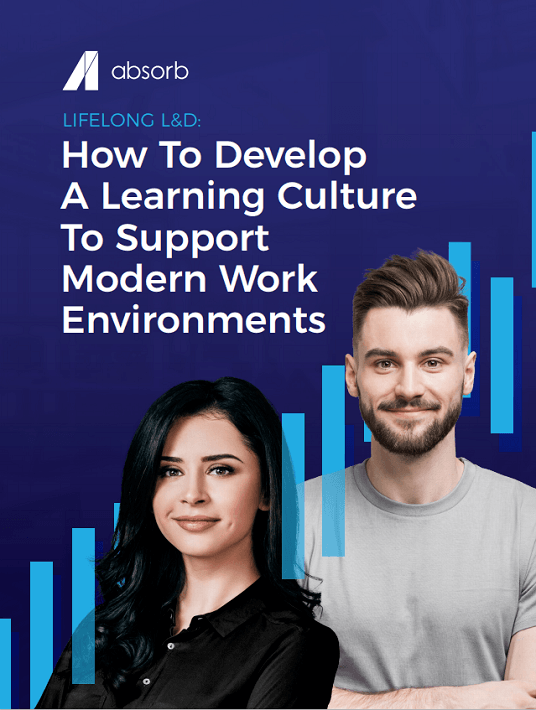How To Create A Continuous Corporate Learning Culture
As technology and culture evolve, managers and executives must stay informed and prepare to face future challenges with confidence. A learning management system (LMS) is an integral part of building a lasting, continuous learning culture. Based on all the information provided throughout our eBook, here are the key takeaways to help you build a resilient and effective learning & development program to serve everyone across your organization.

Prioritizing Adaptability
As the pandemic has proven, nothing is guaranteed. Today’s “normal” may no longer exist tomorrow, so learning and development leaders must learn to be flexible and ready to pivot their strategy when required.
As more teams move to fully or partially remote work environments, it’s critical to ensure your training initiatives still reach and engage learners, whether they are in the office or working from home. Managing remote teams is an adjustment, but you can lean on your LMS to deliver online courses and virtual instructor-led training without missing a beat.
Your learners will appreciate the flexible approach to their development and feel empowered to learn at their own pace, no matter where they’re located. LMS mobile apps further amplify the accommodating nature of your learning, showing your teams that their individual needs are a priority for your organization.
Scalability in your LMS is another critical piece of staying adaptable for the far future. A continuous learning culture means that no matter what happens in the life of your company, your dedication to learner development never wanes. An LMS with the capacity to grow with you is a key part of planning for the long-term.
Drive Learner Engagement Through Personalized Learning
According to Brandon Hall, 84% of companies agree or strongly agree that personalized learning supports the development needs of employees; however, only 30% of companies actually create a personalized learning plan most or all of the time.
Personalization can make employees feel more emotionally connected to the company and provides opportunities to learn in conjunction with coworkers. This creates stronger bonds that make teams better and more invested in the business, essentially creating a strong learning culture.
Personalized learning comes in many forms, such as:
- Matching learning to professional goals.
- Creating learning specific to a department or hierarchical position.
- Matching learning to visual, auditory, or kinesthetic learning styles.
- Giving learners options of courses to fulfill compliance requirements.
- Giving learners some control over pace, method, location, and time of the learning.
- Providing a personalized, branded learning environment.
- Creating opportunities for collaboration and social learning.
Regardless of which option(s) you choose to pursue, personalized learning also indicates to employees that their company cares about the individual needs of their professionals. Even in a large company, it can prevent an employee from feeling like an unimportant gear in a corporate machine and can generate buy-in for your continuous learning culture.
Lean Into Your Managers And Leaders As Learning Advocates
Company culture and work ethic trickle down from the top, so if your leaders aren’t the drivers of your learning culture, your entire organization will suffer. A strong foundation for a continuous learning culture begins with the full support of your organization’s top influencers: your executives and managers.
Get buy-in from your top executives by making clear connections between learning goals and organizational goals. Once they understand the commitment needed to create a learning culture, and the major payoffs that come with it, your managers can act as the hands-on advocates for learning. As the link that connects the employee to the organization, managers can bring the valuable insight into their employees skills sets to help create personalized learning paths for their people.
Managers should also receive the proper training to help them play an active role in creating a continuous learning culture: supporting their employees’ learning goals, creating positive learning habits and ultimately impacting the business.
Stay Informed To Make Data-Driven Decisions
If you aren’t immersed in your learner’s progress and experience, your L&D strategy will eventually fall flat. A continuous learning culture requires data-driven iteration and experimentation, not a rigid, unchanging plan.
In order to provide your learners with the optimal experience, you will need to consistently pull data from your LMS to keep a pulse on engagement, performance, and areas of opportunity or optimization. Your LMS will help you get a complete picture of each learner with reports on learner progress, activity, competency and certificates. You can also delve into broader insight on department or team performance, content evaluations and more to understand the state of your organization at any moment.
Empower yourself to take more effective actions backed by the power of your analytics.
Ask Your Learners!
This one is key. If building a culture of learning at your organization is your goal, who better to help guide what that culture should look like than the people it’s being created for?
By asking your learners some key questions, you can better understand the areas of opportunity they’ve already identified. These could span knowledge gaps, specific skills, or even the ways they prefer to learn such as through gamification, social learning tools, forums, microlearning, video and so on.
Capturing this feedback is as easy as sending out an email, asking face-to-face, or better yet, utilizing the survey feature through an LMS. This way, all your responses are located right in your learning system—it’s almost a little ironic, don’t you think?
Regardless of how you ask them, this will be invaluable information to help shape your learning culture in a way that best suits the people it’s intended for.
The Future Is Always In Motion
No one knows exactly what the road ahead will bring, but by investing in an LMS and making the right strategic choices, you can foster a continuous learning culture that will stand the test of time.
Want even more tips on creating a thriving learning culture? Download the eBook ‘Lifelong L&D: How To Develop A Continuous Learning Culture To Support Modern Work Environments’ for those strategic tips, plus evolving L&D trends and best practices to support your modern learners through a learning management system. Also, join the webinar to discover the best L&D approach for remote or hybrid work environments.
References:
KnowledgeGraphic: The State of Personalized Learning







![Lifelong L&D: How To Develop A Learning Culture To Support Modern Work Environments [eBook]](https://cdn.elearningindustry.com/wp-content/uploads/2021/05/shutterstock_1297466617.png)


